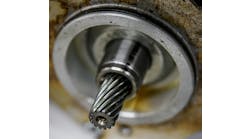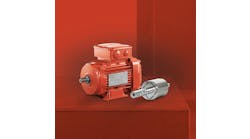Greg Dieck is product manager, motion, at Omron Automation.
What have been the biggest improvements to motor and drives in the past five years?
Greg Dieck, product manager, motion, Omron Automation: The acceptance of industrial networks, especially deterministic, such as EtherCAT, for servo solutions has brought many improvements. Ease of wiring, extremely fast operation and monitoring allows us to improve the efficiency of the system. Using a network helps with configuration, control and even maintenance of the servos. Being able to collect data from the servo in real time allows that data to be used in machine-learning engines for artificial intelligence (AI) to help predict failures and anomalies that can create downtime and affect machine performance and overall equipment efficiency (OEE).
Mechanical changes have helped from design to maintenance. Drive designs have allowed for side-by-side mounting, as well as wiring connector placement help with the amount of space required for the servo drives. Single cable between the drive and motor allows motor power, brake and feedback together in one cable and helps assembly and maintenance for time savings.
Motors are getting even more efficient and handling larger loads with smaller motors. Drive response time and higher resolution encoders help to tune motors for faster response and higher accuracies. This improves machine performance as well as accuracy to help reduce scrap.
What’s the most innovative or efficient motor/drive application you’ve ever seen or been involved with?
Greg Dieck, product manager, motion, Omron Automation: When paired with the right controller, networked motors and drives can be used in demanding applications, like 2D and 3D additive and subtractive manufacturing, for complex coordinated multi-axis tooling.
Also read: Ease of use dominates motor and drive trends
Some demanding applications will utilize many facets of the drive and motor capabilities. In past complex applications we have switched between position and torque mode on the fly to press in a seal at the required force, but still a very precise position. Programming has utilized position, velocity and torque monitoring from the motor to create collision detection that can quickly stop axis of motion to keep mechanical actuators from being damaged during operation. This was then turned into a function block that was easily replicated on other parts of the machine.
How have motors and drives benefitted from remote monitoring and connectivity?
Greg Dieck, product manager, motion, Omron Automation: Monitoring motors and drives allows us to analyze many aspects of the application. We can watch the system for potential failures and warn about issues before they happen, and we can also monitor and learn how systems respond and watch for anomalies.
By using the data in an AI engine, we can then constantly evaluate performance and start to predict future problems before they arise. With the advanced warning capabilities in some drives, they can send a warning for issues like a cooling fan stopped, torque is approaching overload and even capacitor life expectancy to the controller so maintenance can look at and fix before a machine shutdown happens.
Can you explain how software development has changed the motor and drive design and production?
Greg Dieck, product manager, motion, Omron Automation: Software has helped bring efficiency during the design, configuration, manufacturing and maintenance stages. With a single software package everyone can learn one software for the entire machine. Software that configures and programs all facets of the machine allows for shared-tag databases, as well as simplified programming between components, such as HMI, PLC, servo and safety. Simulation can then be integrated into the software and be utilized for machine design and performance. This can also allow for a single point of connection to the machine, which helps tremendously when remote monitoring is being utilized.
How do motors and drives figure into digital-twin platform models being used by manufacturers?
Greg Dieck, product manager, motion, Omron Automation: With new simulation and digital twin, software engineers are able to look at how the concept is working and investigate ways to improve machine throughput as well as interoperability among the mechanical design in a virtual environment. This helps in not only machine design, but production improvements and life cycle management. By combining multiple components together, the complete process can be studied and analyzed.
When will motors and drives become IT-friendly enough that engineers are no longer required for installation and operation?
Greg Dieck, product manager, motion, Omron Automation: Engineers remain to be critical through machine design, configuration and programming. With the use of the industrial networks, troubleshooting and maintaining can be improved during operation and maintenance of the machine. We utilize the network to get detailed warnings and errors from the drive and can then get those details to the HMI in the form of directive text, pictures or even videos to help correct the problem and be back into full production as quickly as possible. We are starting to store configuration and tuning parameters in the controller and, through the HMI, download them to a replacement servo drive to save time during drive replacements.
What future innovations will impact the use of motors and drives in discrete manufacturing operations?
Greg Dieck, product manager, motion, Omron Automation: Ultimately what will impact the industry the most is the speeds and accuracies that we can operate at. This will allow faster, more efficient production. Manufactures that can provide a flexible universal amplifier that delivers world class positioning, speed and accuracy, while also being able to control any type of motor and feedback, will help eliminate mechanical limitations in machine designs.
Tell us about your company’s state-of-the-art motor or drive.
Greg Dieck, product manager, motion, Omron Automation: Omron is releasing its next servo drive and motor. This drive will add safety functions to the popular 1S servo that we offer. This will expand Omron’s thorough safety line of products by bringing safe motion to the solution. These safety functions will not only make the machine safer for the people operating and maintaining the machine but also will help efficiency in production by allowing safe access to the machine during operation. Utilizing fail safe over EtherCAT (FSoE) helps us to achieve PLe/SIL3, according to the EN 61800-5-2 standard.





